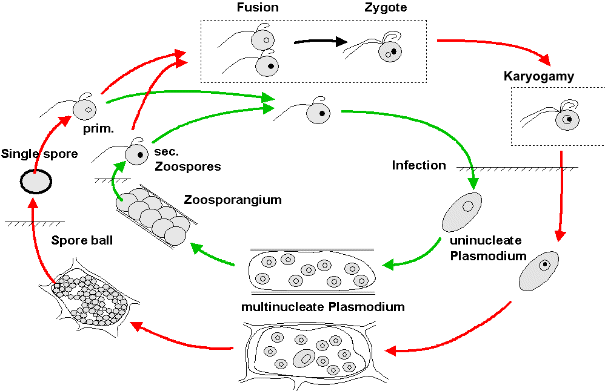
The genus Spongospora is a member of the family of the Plasmodiophoridae, which have recently been shifted from the fungi to the Protozoa kingdom. Other important members of this family are Plasmodiophora brassicae, the causative agent of clubroot and Polymyxa graminis and Polymyxa betae, both vectors of viruses. They all do not have hyphae, spread with zoospores, the infecting stage is a plasmodium and they survive as resting spores. The pathogens are soil-borne.
There are two major phases in the life cycle of the Genus Spongospora, each initiated by host cell infection through single uninucleate plasmodium:
1) The sporogenic phase (outer circle): After nuclear divisions within the sporogenic plasmodium, the pathogen produces spore balls consisting of thick-walled resting spores (sporosori) which are highly persistent. Each spore releases a single biflagellate primary zoospore which can infect the hosts root system. It has been observed with S. subterranea f.sp. subterranea that on dry media the resting spores may release amoeba instead of zoospores.
2) In the sporangial phase, thin-walled sporangia, within which secondary
zoospores are formed from a sporangiogenous plasmodium, develop in the hosts
cells (inner circle). The secondary, also biflagellate zoospores can exit
the hosts and initiate another infection cycle.

Little is known about the encircled parts. All members of Spongospora are obligate parasites and can only be cultivated on host plants. Only Spongospora subterranea f.sp. subterranea is also a vector (of the Mop-Top Furovirus).
Back to SPONGOSPORA Competence Center / Members of the Genus / References / Places and People / Slide-Shop